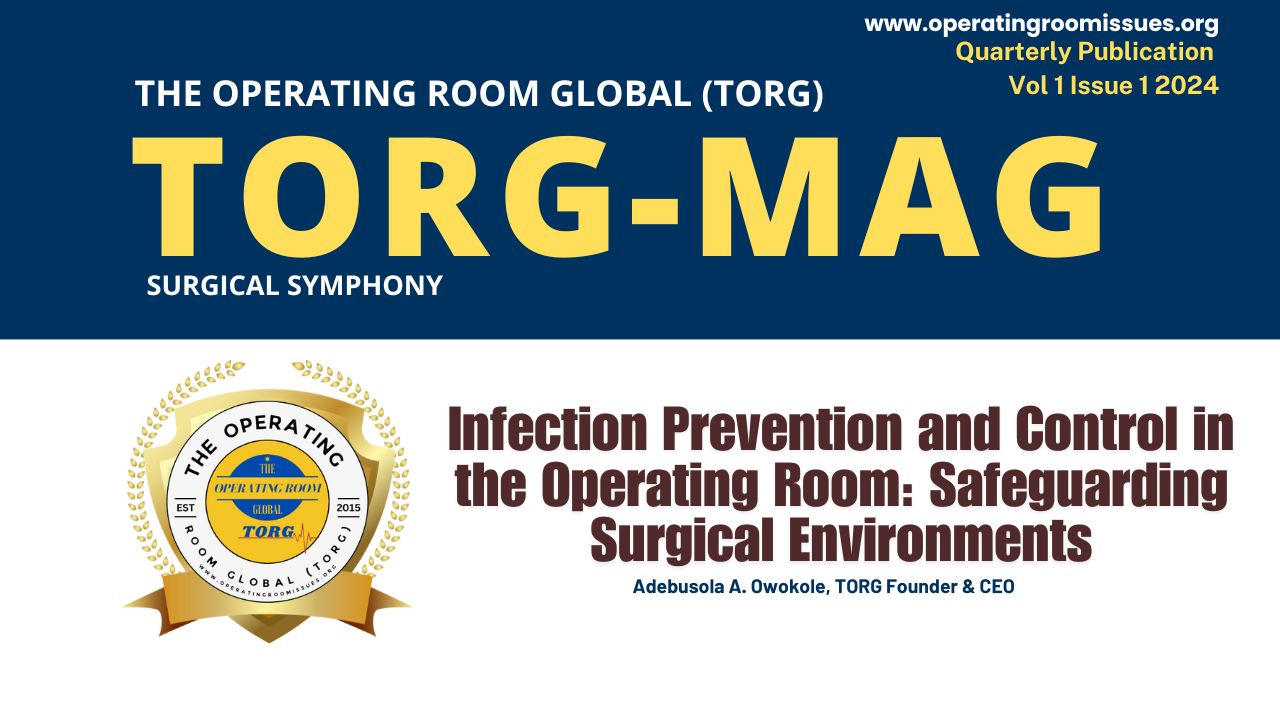TORG-MAG Vol 1 Issue 1, Aug. 2024, P. 36
By Adebusola A. Owokole, TORG Founder & CEO
Cite this Article: Owokole, A.A. (2024) ‘Infection Prevention and Control in the Operating Room: Safeguarding Surgical Environments’, TORG-MAG, Vol. 1, Issue 1, p. 36. Available at: https://torgevents.org/infection-prevention-and-control/
Abstract

In the dynamic and critical setting of the Operating Room (OR), Infection Prevention and Control (IPC) measures play a pivotal role in ensuring patient safety and positive surgical outcomes.
This article explores the significance of IPC in the OR, examining guidelines, protocols, and innovations that contribute to maintaining a sterile environment. From hand hygiene to advanced technologies, the comprehensive approach to infection prevention is essential for reducing the risk of Surgical Site Infections (SSIs) and enhancing overall healthcare quality.
Keywords: Infection Prevention, Operating Room, Surgical Site Infections, Sterile Environment, Healthcare Quality, Hand Hygiene, IPC Guidelines, Advanced Technologies.
Introduction
The operating room is a hub of precision and expertise, where medical professionals work diligently to perform life-saving procedures.
However, amidst the intricacies of surgery, the risk of infections cannot be ignored. Infection prevention and control (IPC) measures are critical in mitigating this risk and ensuring patient safety.
This article delves into the key aspects of IPC in the operating room, examining guidelines, best practices, and innovative technologies that contribute to maintaining a sterile environment. In the OR, where surgical interventions expose patients to potential pathogens, maintaining a sterile environment is paramount. Surgical site infections (SSIs) pose a significant threat, potentially leading to prolonged hospital stays, increased healthcare costs, and compromised patient outcomes. IPC strategies focus on preventing the introduction of pathogens into the surgical site, minimizing the risk of SSIs, and enhancing overall healthcare quality.
Hand Hygiene as a Fundamental Measure
At the core of IPC in the operating room is stringent hand hygiene. Healthcare professionals, including surgeons, nurses, and support staff, adhere to meticulous hand hygiene protocols before and after patient contact. Proper handwashing techniques, coupled with the use of hand sanitizers, significantly reduce the transmission of microorganisms and help create a sterile environment crucial for successful surgeries.
Adherence to IPC Guidelines
IPC guidelines, established by reputable healthcare organizations, serve as a cornerstone for maintaining standards in the operating room. These guidelines encompass a spectrum of measures, from pre-operative preparations to post-operative care. Key elements include the proper sterilization of surgical instruments, the use of aseptic techniques during procedures, and the appropriate disposal of biomedical waste. Adherence to these guidelines not only prevents infections but also promotes a culture of safety and accountability among healthcare professionals.
Advanced Technologies in IPC
The integration of advanced technologies has revolutionized IPC in the operating room. Innovations such as ultraviolet (UV) light sterilization, antimicrobial surfaces, and robotics contribute to creating a safer surgical environment. UV light, for instance, effectively eliminates pathogens on surfaces and in the air, complementing traditional cleaning methods. Antimicrobial surfaces hinder the growth of bacteria, further reducing the risk of contamination. Robotics, with their precision and automation, minimize human intervention, thereby decreasing the likelihood of errors in infection control procedures.
Challenges and Future Directions
Despite advancements, challenges persist in achieving optimal IPC in the operating room. Issues such as antibiotic resistance, evolving pathogens, and resource constraints demand ongoing efforts in research and development. Future directions in IPC include the exploration of nanotechnology for targeted disinfection, the integration of artificial intelligence for real-time monitoring of infection risks, and the development of biodegradable materials to reduce environmental impact.
In conclusion, infection prevention and control in the operating room are indispensable for safeguarding patient well-being and optimizing surgical outcomes. From fundamental practices like hand hygiene to the incorporation of cutting-edge technologies, a comprehensive approach is necessary to create and maintain a sterile environment. Adherence to established guidelines, coupled with ongoing research and innovation, ensures that the operating room remains a bastion of safety and excellence in healthcare. By prioritizing infection prevention, healthcare professionals contribute to a future where surgical interventions are not only life-saving but also free from the threat of infections.
References
- Allegranzi, B., Bagheri Nejad, S., Combescure, C., et al. (2011). Burden of endemic health-care-associated infection in developing countries: systematic review and meta-analysis.
- Centers for Disease Control and Prevention. (2021). Guidelines for Perioperative Infection Prevention.
- Nerandzic, M. M., & Donskey, C. J. (2013). Activatable disinfectants for infection control.
- Otter, J. A., Yezli, S., French, G. L. (2013). The role played by contaminated surfaces in the transmission of nosocomial pathogens.
- World Health Organization. (2019). Guidelines on Hand Hygiene in Health Care.
Cite this Article:
Owokole, A., 2024. Infection prevention and control in the operating room: safeguarding surgical environments. TORG-MAG, 1(1), p. 36, 7 August. Available at: https://torgevents.org/infection-prevention-and-control/ [Accessed 2024].
TORG Magazine (TORG-MAG)
Maiden Edition: Surgical Symphony, Issue 1 Vol 1 Aug 2024
Stay ahead in the field of surgical practice with TORG-MAG, the quarterly publication from The Operating Room Global (TORG).
✓ Fill out the Form Below and submit
